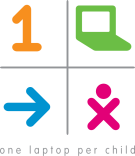
Back حاسوب محمول لكل طفل Arabic OLPC AST One Laptop per Child Spanish One Laptop per Child Estonian یک لپتاپ برای هر کودک Persian One Laptop per Child Finnish One Laptop per Child French OLPC HE OLPC HT One Laptop Per Child ID
 | |
| Formation | January 28, 2005 |
|---|---|
| Type | Non-profit |
| Headquarters | Miami, Florida, U.S. |
Official language | Multilingual |
Founder | Nicholas Negroponte[1][2] |
Key people | |
| Website | laptop |
One Laptop per Child (OLPC) was a non-profit initiative established with the goal of transforming education for children around the world; this goal was to be achieved by creating and distributing educational devices for the developing world, and by creating software and content for those devices.
When the program launched in 2005, the typical retail price for a laptop was considerably in excess of $1,000 (US), so achieving this objective required bringing a low-cost machine to production. This became the OLPC XO Laptop, a low-cost and low-power laptop computer designed by Yves Béhar[3] with Continuum, now EPAM Continuum.[4] The project was originally funded by member organizations such as AMD, eBay, Google, Marvell Technology Group, News Corporation, and Nortel. Chi Mei Corporation, Red Hat, and Quanta provided in-kind support. After disappointing sales, the foundation shut down in 2014.[1]
The OLPC project was the subject of much discussion. It was praised for pioneering low-cost, low-power laptops and inspiring later variants such as Eee PCs and Chromebooks; for assuring consensus at ministerial level in many countries that computer literacy is a mainstream part of education; for creating interfaces that worked without literacy in any language, and particularly without literacy in English.
It was criticized from many sides regarding its US-centric focus ignoring bigger problems, high total costs, low focus on maintainability and training and its limited success. The OLPC project is critically reviewed in a 2019 MIT Press book titled The Charisma Machine: The Life, Death, and Legacy of One Laptop per Child.[5]
- ^ a b Robertson, Adi (April 16, 2018). "OLPC's $100 laptop was going to change the world – then it all went wrong". The Verge. Retrieved July 10, 2020.
- ^ "Contradictheory: Digitalisation is not about giving everyone a smartphone | The Star". thestar.com.my. Retrieved July 10, 2020.
- ^ "The Story Behind the One Laptop per Child PC: An Inteview [sic] with Yves Béhar". User Experience. March 2011. Retrieved October 7, 2022.
- ^ "__Millions of schoolchildren don't have access to the educational resources__ that provide them with the __right start in life.__". Archived from the original on September 26, 2020.
- ^ Ames, Morgan G. (November 19, 2019). The Charisma Machine: The Life, Death, and Legacy of One Laptop per Child. MIT Press. ISBN 9780262353908.
© MMXXIII Rich X Search. We shall prevail. All rights reserved. Rich X Search